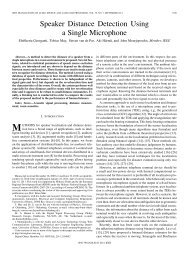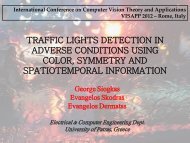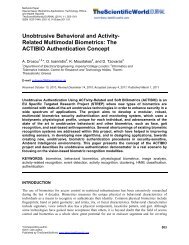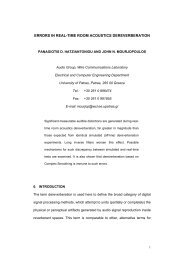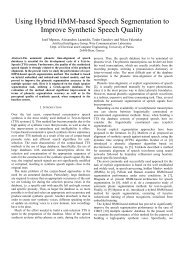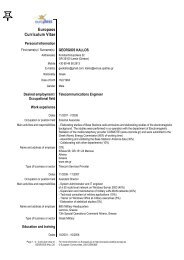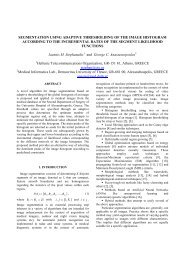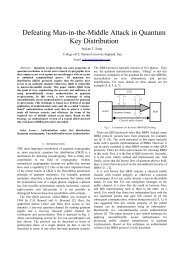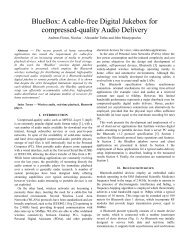A2.5 A Simplified Blocking Probability Calculation in the Retry Loss ...
A2.5 A Simplified Blocking Probability Calculation in the Retry Loss ...
A2.5 A Simplified Blocking Probability Calculation in the Retry Loss ...
Create successful ePaper yourself
Turn your PDF publications into a flip-book with our unique Google optimized e-Paper software.
A <strong>Simplified</strong> <strong>Block<strong>in</strong>g</strong> <strong>Probability</strong> <strong>Calculation</strong> <strong>in</strong><strong>the</strong> <strong>Retry</strong> <strong>Loss</strong> Models for F<strong>in</strong>ite SourcesIoannis D. Moscholios, Michael D. Logo<strong>the</strong>tis and George K. Kokk<strong>in</strong>akisWCL, Dept. of Electrical & Computer Eng<strong>in</strong>eer<strong>in</strong>g, University of Patras, 265 00 Patras, GreeceE-mail: {moscholios, m-logo, gkokk<strong>in</strong>}@wcl.ee.upatras.grAbstract-We consider <strong>the</strong> s<strong>in</strong>gle and multi-retry loss modelsfor f<strong>in</strong>ite sources (f-SRM, f-MRM, respectively) <strong>in</strong> whichcalls of K service-classes are accommodated <strong>in</strong> a l<strong>in</strong>k ofcapacity C and compete for <strong>the</strong> available bandwidth under<strong>the</strong> complete shar<strong>in</strong>g (CS) policy. Blocked calls canimmediately retry one or more times to be connected <strong>in</strong> <strong>the</strong>system with reduced bandwidth and <strong>in</strong>creased service timerequirements. In both f-SRM and f-MRM <strong>the</strong> calculation of<strong>the</strong> l<strong>in</strong>k occupancy distribution can be quite complex s<strong>in</strong>ce itrequires enumeration and process<strong>in</strong>g of <strong>the</strong> state space. Tosimplify this calculation and consequently <strong>the</strong> calculation ofblock<strong>in</strong>g probabilities, we present an approximate methodbased on <strong>the</strong> correspond<strong>in</strong>g retry loss models of <strong>in</strong>f<strong>in</strong>itesources. Simulation results verify <strong>the</strong> method’s accuracy.Keywords: <strong>Loss</strong> System; F<strong>in</strong>ite Population; Retrials; <strong>Block<strong>in</strong>g</strong><strong>Probability</strong>; Recurrent Formula.I. INTRODUCTIONThe wireless multi-service network<strong>in</strong>g environmentnecessitates <strong>the</strong> use of teletraffic models with f<strong>in</strong>ite sourcepopulation for <strong>the</strong> assessment of <strong>the</strong> call-level QoS [1].The basic multi-rate loss model for f<strong>in</strong>ite sources refersto fixed-rate traffic and we name it Engset Multirate <strong>Loss</strong>Model (EnMLM), s<strong>in</strong>ce for a s<strong>in</strong>gle service-class, it gives<strong>the</strong> same block<strong>in</strong>g probability results with <strong>the</strong> Engsetformula for <strong>the</strong> time congestion probability [2]. Accord<strong>in</strong>gto <strong>the</strong> EnMLM a l<strong>in</strong>k of capacity C accommodates calls ofK different service-classes under <strong>the</strong> CS policy, i.e. callsare accepted <strong>in</strong> <strong>the</strong> system if <strong>the</strong>ir required bandwidth isavailable. The offered traffic load of each service-class k(k=1,…,K) comes from a f<strong>in</strong>ite number of N k sources. Themodel has a product form solution (PFS) and <strong>the</strong>calculation of <strong>the</strong> l<strong>in</strong>k occupancy distribution G(j), where jis <strong>the</strong> occupied l<strong>in</strong>k bandwidth, is based on an accurateand recursive formula [3].Extensions of <strong>the</strong> EnMLM which cope with elastictraffic are: a) <strong>the</strong> f-SRM [4] and <strong>the</strong> f-MRM [5], <strong>in</strong> whichblocked calls can immediately retry once or many times tobe connected <strong>in</strong> <strong>the</strong> system with reduced bandwidth and<strong>in</strong>creased service time requirements and b) <strong>the</strong> thresholdmodels where calls, prior to be<strong>in</strong>g blocked, may adjust<strong>the</strong>ir bandwidth and service time requirements accord<strong>in</strong>gto ei<strong>the</strong>r a s<strong>in</strong>gle threshold, or a set of thresholds commonto all service-classes or a different set of thresholds foreach service-class [5]. An important consideration formulti-service networks is <strong>the</strong> application of <strong>the</strong> bandwidthreservation policy <strong>in</strong> <strong>the</strong> above mentioned models [1],[6].In all <strong>the</strong>se extensions <strong>the</strong> PFS is destroyed and <strong>the</strong>reforeonly approximate but recursive G(j)’s formulas areavailable. Fur<strong>the</strong>rmore, <strong>in</strong> both <strong>the</strong> EnMLM and itsextensions <strong>the</strong> G(j)’s determ<strong>in</strong>ation is more complexcompared to that <strong>in</strong> <strong>the</strong> correspond<strong>in</strong>g <strong>in</strong>f<strong>in</strong>ite sourcemodels ([7]-[10]), s<strong>in</strong>ce <strong>the</strong> system’s state space needsenumeration and process<strong>in</strong>g prior to <strong>the</strong> G(j)’s calculation.In <strong>the</strong> case of <strong>the</strong> EnMLM one can overcome <strong>the</strong> statespace enumeration and process<strong>in</strong>g by an approximatemethod proposed, <strong>in</strong> [11], by Glabowski and Stasiak(G&S method) which is based on <strong>the</strong> correspond<strong>in</strong>g<strong>in</strong>f<strong>in</strong>ite source model, <strong>the</strong> classical Erlang Multirate <strong>Loss</strong>Model (EMLM) [12]. Accord<strong>in</strong>g to [11], <strong>the</strong> number of<strong>in</strong>-service sources, n k , of service-class k <strong>in</strong> a state j of anEnMLM system is approximated by <strong>the</strong> average number,y k (j), of service-class k calls <strong>in</strong> <strong>the</strong> same state j of <strong>the</strong>correspond<strong>in</strong>g EMLM system. The values of y k (j) areeasily computed via <strong>the</strong> well-known Kaufman-Robertsformula ([7],[8]) and <strong>the</strong>n replace <strong>the</strong> correspond<strong>in</strong>g n k ’s<strong>in</strong> <strong>the</strong> G(j)’s calculation of <strong>the</strong> EnMLM.In this paper we study <strong>the</strong> applicability of <strong>the</strong> G&Smethod <strong>in</strong> <strong>the</strong> case of <strong>the</strong> f-SRM and f-MRM. Itsapplication requires <strong>the</strong> knowledge of <strong>the</strong> average numberof service-class k calls <strong>in</strong> each state j from <strong>the</strong>correspond<strong>in</strong>g s<strong>in</strong>gle and multi-retry models (SRM andMRM, respectively) for <strong>in</strong>f<strong>in</strong>ite number of sources [9].The analytical block<strong>in</strong>g probability results obta<strong>in</strong>ed by <strong>the</strong>G&S method are <strong>in</strong> accordance with simulation results.The rema<strong>in</strong>der of <strong>the</strong> paper is as follows: In Section IIwe review <strong>the</strong> f-SRM and <strong>the</strong> f-MRM. In Section II.A wepresent <strong>the</strong> analytical model of <strong>the</strong> f-SRM while <strong>in</strong>Section II.B <strong>the</strong> analytical model of <strong>the</strong> f-MRM. InSection II.C we present, through a simple example, <strong>the</strong>method for <strong>the</strong> state space determ<strong>in</strong>ation <strong>in</strong> <strong>the</strong> case of <strong>the</strong>f-SRM. In Section III we proceed with <strong>the</strong> application of<strong>the</strong> G&S method <strong>in</strong> both models. Numerical results arepresented <strong>in</strong> Section IV. In Section V we conclude.II. THE RETRY MODELS FOR FINITE SOURCESA. The f-SRM - <strong>the</strong> analytical modelWe assume a l<strong>in</strong>k of capacity C bandwidth units (b.u.)that accommodates calls of K service-classes whichcompete for <strong>the</strong> available bandwidth under <strong>the</strong> CS policy.Each service-class k has a f<strong>in</strong>ite source population N k andrequires b k b.u per call. Service-class k calls arrive to <strong>the</strong>l<strong>in</strong>k accord<strong>in</strong>g to a quasi-random process [2], with meanarrival rate λ k =(N k - n k )v k , where n k is <strong>the</strong> number of <strong>in</strong>servicesources and v k is <strong>the</strong> mean arrival rate per idlesource. The offered traffic load per idle service-class k−1source is α k =v k /µ k where µ k is <strong>the</strong> mean service time,exponentially distributed. Blocked service-class k callsretry to be connected <strong>in</strong> <strong>the</strong> system with parameters (b kr ,µ ) where b kr < b k and µ > µ . The f-SRM does not−1kr−1krhave a PFS and <strong>the</strong>refore <strong>the</strong> G(j)’s calculation is based onan approximate recursive formula [4]:−1k
⎧1 for j = 0⎪K1⎪ ∑(N−n+ 1)αk bkG(j -bk) (1)⎪j k kk= 1G(j)= ⎨K⎪ 1+⎪ ∑(N−(n+ n ) + 1)αkrbkrγk(j)G(j-bkr) for j = 1,...,Cj k k krk= 1⎪⎩0 o<strong>the</strong>rwisewhere: n kr is <strong>the</strong> <strong>in</strong>-service retry calls of service-class k,−1α kr =v kr µ kr (offered traffic load per idle source of retryservice-class k calls), γ k (j)=1 when j >C-(b k -b kr ).The proof of eq.(1) is based on two assumptions [4]: 1)<strong>the</strong> existence of local balance, which appears only <strong>in</strong> PFSmodels and 2) <strong>the</strong> application of <strong>the</strong> migrationapproximation (M.A.) which assumes that <strong>the</strong> populationof retry service-class k calls are negligible when j ≤C-(b k -b kr ). The existence of M.A. <strong>in</strong> eq.(1) is expressed by <strong>the</strong>variable γ k (j). Call block<strong>in</strong>g probabilities (CBP) ofservice-class k, B kr , is <strong>the</strong> probability of a call to beblocked with its retry bandwidth and is given by:C−1CB = ∑ G G(j) , wherekrG = ∑ G(j)(2)j= C− bkr+ 1j=0Note: By <strong>the</strong> term CBP we mean time congestionprobabilities. For quasi-random arrivals, <strong>the</strong>re is adist<strong>in</strong>ction between time and call congestion probabilities.These probabilities co<strong>in</strong>cide <strong>in</strong> <strong>the</strong> case of Poisson arrivals(PASTA property [2]). Time congestion probability isdeterm<strong>in</strong>ed by <strong>the</strong> proportion of time <strong>the</strong> system iscongested and can be measured by an outside observer.When N k approaches <strong>in</strong>f<strong>in</strong>ity for k =1,…,K <strong>the</strong>n <strong>the</strong>SRM results. In that case <strong>the</strong> G(j)’s calculation is based on<strong>the</strong> follow<strong>in</strong>g approximate but recursive formula [9]:⎧1 for j = 0⎪K⎪ 1⎪ ∑α k b k G(j - b k )jk = 1(3)G(j) = ⎨K⎪ 1⎪+γ (j)G(j - ) for j = ,..., C∑ α kr b kr k b kr 1⎪ jk = 1⎪⎩0 o<strong>the</strong>rwise−1−1where: α k =λ k µ k ,α kr =λ k µ kr and γ k (j)=1 when j>C-(b k -b kr ).The proof of eq. (3) is based on <strong>the</strong> assumptions of eq.(1), while <strong>the</strong> CBP of service-class k, B kr is determ<strong>in</strong>ed byeq. (2). Based on eq. (3), one can calculate, <strong>in</strong> state j, <strong>the</strong>average number of service-class k calls ei<strong>the</strong>r with b k b.u.,y k (j), or with b kr b.u, y kr (j):y ( j)= a G(j − b ) G(j)(4)kkwhere: j-b k > 0kykr( j)= akrγ k ( j)G(j − bkr) G(j)(5)where: j-b kr > 0 and γ k (j)=1 when j >C-(b k -b kr ).B. The f-MRM - <strong>the</strong> analytical modelIn <strong>the</strong> f-MRM, a blocked service-class k call may retrymany times with “retry parameters” (b krl , µ -1 krl ) for−1l=1,…,s(k), where b krs(k) −1µ k .µ krs(k )Similar to <strong>the</strong> f-SRM, <strong>the</strong> f-MRM does not have a PFSand <strong>the</strong>refore <strong>the</strong> G(j)’s calculation is based on <strong>the</strong>follow<strong>in</strong>g approximate recursive formula [5]:⎧1for j = 0⎪ K⎪1⎪ ∑[Nk−nk+ 1] akbG k ( j−bk)⎪jk=1G(j)= ⎨K s(k)⎪ 1⎪+∑∑[ Nk−(nk+ nkr+... + nkr+... + nl⎪ j1k= 1 l=1⎪⎩0o<strong>the</strong>rwisekrs( k)) + 1] a b γ ( j)G(j−b) forj = 1,..., Ckrlkrlkrlwhere: n krl is <strong>the</strong> <strong>in</strong>-service retry service-class k calls withb krl , α krl =v krl µ -1 krl , while γ kl (j)=1 when C ≥ j>C-(b krl-1 - b krl ).The CBP of a service-class k, denoted as B krs(k) , is <strong>the</strong>probability of a call to be blocked with its last bandwidthrequirement and is calculated by:Bkrs(k)krl(6)C1∑ G−C= G(j), where G = ∑ G(j) (7)j=C−bkr s+ 1( k )j=0When N k approaches <strong>in</strong>f<strong>in</strong>ity for k =1,…,K <strong>the</strong>n <strong>the</strong> MRMresults and <strong>the</strong> G(j)’s calculation is based on [9]:⎧1for j = 0⎪ K⎪ 1⎪ ∑a k bkG(j − bk)⎪jk = 1G(j)= ⎨K s(k )⎪ 1⎪+∑∑akr blkr γl⎪ jk = 1 l = 1⎪⎩0o<strong>the</strong>rwisek l( j)G(j − bkrl) for j = 1,..., C−1where: α k =λ k µ k, α krl =λ k µ -1 krl and γ kl (j)=1 when C≥j>C-(b krl-1 -b krl ), o<strong>the</strong>rwise γ kl (j) = 0.Hav<strong>in</strong>g determ<strong>in</strong>ed <strong>the</strong> values of G(j)’s through eq. (8),<strong>the</strong>n CBP of service-class k calls, B krs(k) , are given by eq.(7), <strong>the</strong> average number of service-class k calls, <strong>in</strong> state j,with b k b.u., y k (j), by eq. (4) and <strong>the</strong> average number ofservice-class k calls with b krl b.u, y kr l(j) by <strong>the</strong> equation:ykr( j)= a ( j)G(j b ) G(j)l kr γl k −lkr(9)lwhere: j-b krl >0 and γ kl (j)=1 when j>C-(b krl-1 –b krl ),o<strong>the</strong>rwise γ kl (j) = 0.C. State space determ<strong>in</strong>ation and G(j)’s calculation <strong>in</strong> <strong>the</strong>f-SRMConsider a l<strong>in</strong>k of capacity C = 5 b.u. and two serviceclasseswhose calls require b 1 =3 and b 2 =2 b.u.,respectively. The offered traffic load per idle source is α 1= α 2 = 0.01 erl, while <strong>the</strong> number of sources is N 1 =N 2 =6.Blocked 1 st service-class calls retry with reducedbandwidth, b 1r =1 b.u, and <strong>in</strong>creased offered trafficα 1r =0.03 erl, so that <strong>the</strong> total offered traffic load per idlesource rema<strong>in</strong>s <strong>the</strong> same (α 1 b 1 = α 1r b 1r ). Due to <strong>the</strong> M.A.retry calls of <strong>the</strong> 1 st service-class are assumed to benegligible when <strong>the</strong> occupied l<strong>in</strong>k bandwidth j≤C–(b 1 –b 1r )⇒ j ≤ 3. Tak<strong>in</strong>g <strong>in</strong>to account <strong>the</strong> M.A. assumption, <strong>the</strong>state space consists of 8 states (n 1 , n 2 , n 1r ), presented <strong>in</strong>(8)
Table I toge<strong>the</strong>r with <strong>the</strong> respective occupied l<strong>in</strong>kbandwidth (j) and <strong>the</strong> block<strong>in</strong>g states (B 1 , B 2 , B 1r ), whereB k (k=1,2) expresses <strong>the</strong> CBP of service-class k calls withb k b.u, calculated by eq. (2) if one replaces b kr with b k .Accord<strong>in</strong>g to Table I <strong>the</strong> values of j = 4, 5 appear morethan once, and <strong>the</strong>refore it is impossible to use directly eq.(1) for <strong>the</strong> calculation of G(j)’s (e.g. <strong>the</strong> value j = 4,corresponds to both (n 1 , n 2 , n 1r ) = (0,2,0) and (1,0,1)). Toovercome this problem, <strong>the</strong> authors proposed a methodwhereby an equivalent stochastic system is determ<strong>in</strong>edwith <strong>the</strong> follow<strong>in</strong>g three characteristics [5]:a) The states (n 1 , n 2 , n 1r ) of <strong>the</strong> equivalent system are <strong>the</strong>same with <strong>the</strong> <strong>in</strong>itial one.b) Each state (n 1 , n 2 , n 1r ) of <strong>the</strong> equivalent system has aunique value for <strong>the</strong> occupied l<strong>in</strong>k bandwidth.c) The chosen values of b 1 , b 2 and b 1r of <strong>the</strong> equivalentsystem keep constant (as much as possible) <strong>the</strong> <strong>in</strong>itialratios of b 1 :b 2 :b 1r :C = 3:2:1:5.In our example, <strong>the</strong> values b 1 = 3000, b 2 = 2000, b 1r =1001 and C= 5002, is an approximate solution to <strong>the</strong><strong>in</strong>itial system; for <strong>the</strong>se values we present <strong>in</strong> <strong>the</strong> lastcolumn of Table I <strong>the</strong> unique values of <strong>the</strong> equivalentoccupied l<strong>in</strong>k bandwidth, j eq . The resultant CBP are: B 1 =5.98%, B 2 = 0.66% and B 1r = 0.33%. Note that everysystem that is a multiple of b 1 = 3000, b 2 = 2000, b 1r =1001 and C= 5002 (e.g. b 1 = 6000, b 2 = 4000, b 1r = 2002and C= 10004) gives exactly <strong>the</strong> same CBP.The determ<strong>in</strong>ation of an equivalent system, and thusCBP, can become difficult when calls retry many times.To circumvent this problem we exam<strong>in</strong>e, <strong>in</strong> <strong>the</strong> nextsections, <strong>the</strong> applicability of <strong>the</strong> G&S method <strong>in</strong> <strong>the</strong> f-SRM and f-MRM.TABLE ISTATE SPACE (n 1 , n 2 , n 1r ), OCCUPIED LINK BANDWIDTH j, BLOCKINGSTATES B 1 , B 2 , B 1r AND EQUIVALENT OCCUPIED LINK BANDWIDTH j eq .n 1 n 2 n 1r j B 1 B 2 B 1r j eq0 0 0 0 00 1 0 2 20000 2 0 4 * * 40000 2 1 5 * * * 50011 0 0 3 * 30001 0 1 4 * * 40011 0 2 5 * * * 50021 1 0 5 * * * 5000III. APPLICATION OF THE G&S METHOD IN THE RETRYMODELS FOR FINITE SOURCESAccord<strong>in</strong>g to <strong>the</strong> G&S method, <strong>in</strong>itially proposed <strong>in</strong> <strong>the</strong>case of <strong>the</strong> EnMLM [11], one approximates <strong>the</strong> number of<strong>in</strong>-service sources, n k , of service-class k <strong>in</strong> a state j of anEnMLM system with <strong>the</strong> average number, y k (j), ofservice-class k calls with b k b.u. <strong>in</strong> <strong>the</strong> same state j of anEMLM system.Similar to <strong>the</strong> above, we consider aga<strong>in</strong> <strong>the</strong> simple f-SRM example of <strong>the</strong> previous section and approximate,for each state j = 1,…,5, <strong>the</strong> number of <strong>in</strong>-service sourcesn 1 , n 2 , n 1r with <strong>the</strong> average number y 1 (j), y 2 (j), y 1r (j),respectively, of <strong>the</strong> correspond<strong>in</strong>g SRM system. Note that<strong>in</strong> <strong>the</strong> SRM system: α 1 = α 2 = 0.06 erl and α 1r =0.18 erl.The values of y 1 (j), y 2 (j) are given by eq. (4) while thoseof y 1r (j) by eq. (5). The results are summarized <strong>in</strong> Table II.TABLE IIAVERAGE NUMBER OF CALLS IN EACH STATE j IN THE SRM SYSTEMy 1 (j) y 2 (j) y 1r (j) j0 0 0 00 0 0 10 1 0 21 0 0 30 0.8 2.4 40.9569 0.9569 0.2153 5Hav<strong>in</strong>g calculated y( )’s we cont<strong>in</strong>ue by determ<strong>in</strong><strong>in</strong>g <strong>the</strong>l<strong>in</strong>k occupancy distribution G(j) of <strong>the</strong> f-SRM example,based on <strong>the</strong> follow<strong>in</strong>g equation:⎧⎪⎪⎪G(j) = ⎨⎪ 1⎪+⎪ j⎪⎩K∑k= 11j∑(N −y (j-b)) α b G(j -b )(N −(y (j-b) + y (j-b))) α b γ (j)G(j -b ) forj= 1,...,CkkkrKk= 1kr1 forj = 00kkrkkkkr kr ko<strong>the</strong>rwisekkkr(10)−1where: α kr =v kr µ kr , γ k (j)=1 when j >C-(b k -b kr ).The resultant CBP are: B 1 = 5.98%, B 2 = 0.66% and B 1r =0.33%, which are almost identical to those obta<strong>in</strong>ed by <strong>the</strong>equivalent stochastic system. Note that <strong>the</strong> correspond<strong>in</strong>gsimulation results for <strong>the</strong> f-SRM example are: B 1,sim =5.79%, B 2,sim = 0.65% and B 1r,sim = 0.33%.In <strong>the</strong> case of <strong>the</strong> f-MRM <strong>the</strong> correspond<strong>in</strong>g (to eq.(10)) equation for <strong>the</strong> G(j)’s calculation is <strong>the</strong> follow<strong>in</strong>g:⎧⎪⎪⎪G(j)= ⎨⎪ 1⎪+⎪ j⎪⎩K s(k)∑∑k= 1 l= 11j∑(N −Y (j-bkKk= 1kfor j =(N − y (j-b)) α b G(j -b )kkrlkk)) α b010kkrlkrlklγ (j)G(j-bo<strong>the</strong>rwisekkkrl) for j= 1,...,C(11)where: α krl =v krl µ krl -1 , γ kl (j)=1 when C ≥ j>C-(b krl-1 -b krl ) andY ( j− b ) = y ( j−b) + y ( j−b) + ... + y ( j−b) + ... + y ( j−b).kkrlkkrlkr1 krlkrlkrlkrs( k)krlIV. NUMERICAL EXAMPLEIn this section we compare <strong>the</strong> analytical CBP resultsobta<strong>in</strong>ed by <strong>the</strong> application of <strong>the</strong> G&S method <strong>in</strong> an f-MRM example with simulation results, which are meanvalues of 7 runs with 95% confidence <strong>in</strong>terval.Consider a l<strong>in</strong>k of capacity C=50 b.u. and two serviceclasseswhich require b 1 = 10 and b 2 = 7 b.u., respectively.The offered traffic load (per idle source) of each serviceclassis α 1 =0.06 erl and α 2 =0.2 erl, respectively. Blockedcalls of <strong>the</strong> 1 st service-class reduce <strong>the</strong>ir bandwidthrequirement two times, from 10 to 8 and to 6 b.u. In <strong>the</strong>first case <strong>the</strong> offered traffic load is α 1r1 =α 1 b 1 /b 1r1 =0.075 erlwhile <strong>in</strong> <strong>the</strong> second α 1r2 =α 1 b 1 /b 1r2 =0.1 erl. Blocked calls of<strong>the</strong> 2 nd service-class reduce <strong>the</strong>ir bandwidth requirementonce, from 7 to 4 b.u. The retry offered traffic load of
second service-class calls is α 2r1 =α 2 b 2 /b 2r1 =0.35 erl. Thenumber of sources for both service-classes is N 1 = N 2 =12.The equivalent stochastic system used for <strong>the</strong> CBPcalculation is <strong>the</strong> follow<strong>in</strong>g [5]: C=50006, b 1 =10000,b 2 =7001 b 1r1 =8000, b 1r2 =6000 and b 2r1 =4000. Table IIIshows <strong>the</strong> state space which consists of 30 states.The correspond<strong>in</strong>g MRM system used for <strong>the</strong> y( )’s andCBP calculation, accord<strong>in</strong>g to <strong>the</strong> G&S method, is:C=50 b.u., b 1 =10 b.u., α 1 =0.72 erl, b 1r1 =8 b.u., α 1r1 =0.9erl, b 1r2 =6 b.u., α 1r2 =1.2 erl and b 2 =7 b.u., α 2 =2.4 erl,b 2r1 =4 b.u., α 2r1 =4.2 erl.In Table IV, we present <strong>the</strong> analytical CBP resultsobta<strong>in</strong>ed from <strong>the</strong> equivalent stochastic system and <strong>the</strong>G&S method toge<strong>the</strong>r with <strong>the</strong> correspond<strong>in</strong>g simulationresults. At each po<strong>in</strong>t (P) of Table IV (P= 1,…,6), <strong>the</strong>values of α 1 , α 1r1 , α 1r2 are constant (i.e. α 1 =0.06,α 1r1 =0.075 and α 1r2 =0.1 erl) while those of α 2 , α 2r1 are<strong>in</strong>creased by 0.4/12 and 0.7/12 respectively, (for P=1:α 2 =0.2 and α 2r1 =0.35 erl).Accord<strong>in</strong>g to <strong>the</strong> results of Table IV, one observes that<strong>the</strong> G&S method gives almost <strong>the</strong> same results with <strong>the</strong>equivalent stochastic system’s method. This behaviour hasbeen observed <strong>in</strong> many examples. Fur<strong>the</strong>r study <strong>in</strong> <strong>the</strong>case of more complicated examples or <strong>in</strong> <strong>the</strong> case of <strong>the</strong>threshold models for f<strong>in</strong>ite sources is needed <strong>in</strong> order toverify <strong>the</strong> superiority of <strong>the</strong> G&S method.V. CONCLUSIONWe review <strong>the</strong> f-SRM and <strong>the</strong> f-MRM loss models whereblocked calls try to be connected <strong>in</strong> <strong>the</strong> system withreduced bandwidth and <strong>in</strong>creased service-timerequirements. The calculation of <strong>the</strong> l<strong>in</strong>k occupancydistribution <strong>in</strong> <strong>the</strong>se models and <strong>the</strong>refore of CBP is basedon <strong>the</strong> enumeration and process<strong>in</strong>g of <strong>the</strong> state spacewhich can be complex <strong>in</strong> systems where <strong>the</strong> number ofretrials is large. To simplify <strong>the</strong> CBP calculation weexam<strong>in</strong>e <strong>the</strong> applicability of <strong>the</strong> G&S method, alreadyproposed <strong>in</strong> <strong>the</strong> case of <strong>the</strong> EnMLM, <strong>in</strong> both models.Results show that <strong>the</strong> G&S performs quite well.REFERENCES[1] I. Moscholios, M. Logo<strong>the</strong>tis and M. Koukias, “A State-DependentMulti-Rate <strong>Loss</strong> Model of F<strong>in</strong>ite Sources with QoS Guarantee forWireless Networks”, to appear <strong>in</strong> <strong>the</strong> Mediterranean Journal ofComputers and Networks, 2006.[2] H. Akimaru, K. Kawashima, “Teletraffic – Theory andApplications”, 2 nd edition, Spr<strong>in</strong>ger, Berl<strong>in</strong>, 1999.[3] G. Stamatelos, J. Hayes, “Admission control techniques withapplication to broadband networks”, Computer Communication,vol. 17 , no. 9, September 1994, pp. 663-673.[4] G. Stamatelos, V. Koukoulidis, “Reservation-based bandwidthallocation <strong>in</strong> a radio ATM network”, IEEE/ACM Trans. Network<strong>in</strong>gvol. 5, no.3, June 1997, pp. 420-428.[5] I. Moscholios, M. Logo<strong>the</strong>tis and P. Nikolaropoulos, “Engset multiratestate-dependent loss models”, Performance Evaluation, vol. 59,issues 2-3, February 2005, pp. 247-277.[6] I. Moscholios, M. Logo<strong>the</strong>tis, “Engset multi-rate state-dependentloss models with Qos guarantee”, International Journal ofCommunications Systems, Vol. 19, Issue 1, February 2006, pp. 67-93.[7] J.S. Kaufman, “<strong>Block<strong>in</strong>g</strong> <strong>in</strong> a shared resource environment”, IEEETransactions on Communications, vol.29, no. 10, October 1981,pp.1474-1481.[8] J.W. Roberts, “A service system with heterogeneous userrequirements”, <strong>in</strong>: G. Pujolle (Ed.), Performance of DataCommunications systems and <strong>the</strong>ir applications, North Holland,Amsterdam, 1981, pp. 423-431.[9] J.S. Kaufman, “<strong>Block<strong>in</strong>g</strong> with retrials <strong>in</strong> a completely sharedresource environment”, Performance Evaluation, vol.15, issue 2,June 1992, pp. 99-113.[10] I. Moscholios, M. Logo<strong>the</strong>tis, G. Kokk<strong>in</strong>akis “ConnectionDependent Threshold Model: A Generalization of <strong>the</strong> ErlangMultiple Rate <strong>Loss</strong> Model”, Performance Evaluation, vol. 48, issue1-4, pp. 177-200, May 2002.[11] M. Glabowski, M. Stasiak, “An Approximate Model of <strong>the</strong> Full-Availability Group with Multi-Rate Traffic and a F<strong>in</strong>ite SourcePopulation”, 12 th GI/ITG Conference on Measur<strong>in</strong>g, Modell<strong>in</strong>g andEvaluation of Computer and Comummunication Systems (MMB)and 3 rd Polish-German Teletraffic Symposium (PGTS),MMB&PGTS 2004, Dresden, Germany, 12-15 September 2004.[12] K.W. Ross, “Multiservice <strong>Loss</strong> Models for BroadbandTelecommunications Networks”, Spr<strong>in</strong>ger, London, 1995.TABLE IIISTATE SPACE (n 1 , n 2 , n 1r1 , n 1r2 , n 2r1 ), OCCUPIED LINK BANDWIDTH j,BLOCKING STATES B 1r2 , B 2r1 AND EQUIVALENT OCCUPIED LINKBANDWIDTH j eq .n 1 n 2n 1r1 n 1r2 n 2r1 j B 1r2 B 2r1 j eq0 0 0 0 0 0 00 1 0 0 0 7 70010 2 0 0 0 14 140020 3 0 0 0 21 210030 4 0 0 0 28 280040 5 0 0 0 35 350050 6 0 0 0 42 420060 6 1 0 0 50 * * 500060 7 0 0 0 49 * * 490071 0 0 0 0 10 100001 1 0 0 0 17 170011 2 0 0 0 24 240021 3 0 0 0 31 310031 4 0 0 0 38 380041 5 0 0 0 45 * 450051 5 0 0 1 49 * * 490052 0 0 0 0 20 200002 1 0 0 0 27 270012 2 0 0 0 34 340022 3 0 0 0 41 410032 3 1 0 0 49 * * 490032 4 0 0 0 48 * * 480043 0 0 0 0 30 300003 1 0 0 0 37 370013 2 0 0 0 44 440023 2 0 0 1 48 * * 480023 2 0 1 0 50 * * 500024 0 0 0 0 40 400004 1 0 0 0 47 * * 470015 0 0 0 0 50 * * 50000TABLE IVANALYTICAL AND SIMULATION CBP RESULTSEquivalent G&SSimulationP Stochastic System methodB 1r2 (%) B 2r1 (%) B 1r2 (%) B 2r1 (%) B 1r2 (%) B 2r1 (%)1 3.05 2.03 3.05 2.03 3.23±0.49 1.83±0.132 4.32 2.72 4.32 2.72 4.02±0.32 2.44±0.123 5.78 3.50 5.78 3.50 5.19±0.32 3.20±0.244 7.39 4.36 7.39 4.36 7.01±0.30 3.76±0.295 9.12 5.30 9.13 5.30 8.16±0.49 4.71±0.356 10.94 6.31 10.94 6.31 9.58±0.44 5.67±0.22




